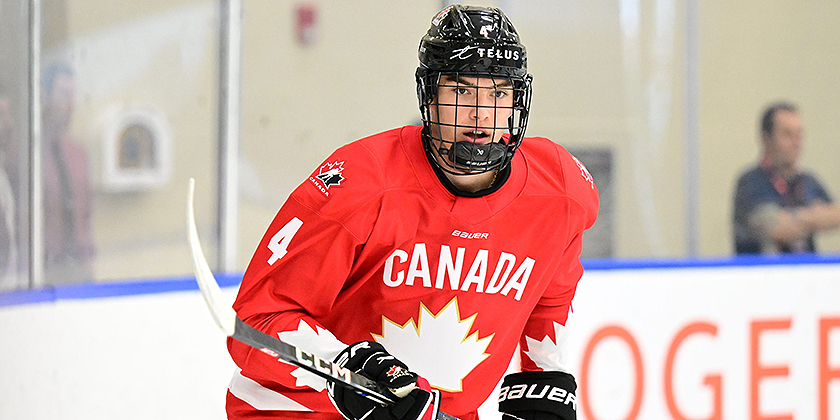
Peyton Kettles (D, R, 6’5″, 190, Swift Current Broncos, 09/01/2007)
Peyton Kettles is a physically imposing, right-shot defenseman with a raw but intriguing toolbox. He plays in all situations for Swift Current, logging over 22 minutes per game and serving on both special teams. Kettles combines elite size with solid puck skills, strong stick-on-puck defending, and offensive upside, but concerns remain around his consistency, off puck decision-making, puck management, skating mechanics, and use of his physicality. A long-term projection, he fits the mold of a developmental prospect who could grow into an everyday NHL defenseman if critical areas of his game improve.
Case For Drafting Kettles:
Kettles has an NHL frame (6’5″, 190 lbs) and already plays top-pair minutes in the WHL — 22:12 TOI per game — including 2:46 on the PK and 1:20 on the power play. He has shown the ability to be deployed in all situations and absorb heavy minutes. His game shows flashes of offensive zone awareness and a willingness to get pucks to the net (3.8 shot attempts/game) while also reading play well enough to generate 0.45 passes per game leading to Grade “A” scoring chances.
His puck touch is strong for a defender of his size. He routinely retrieves and moves pucks under pressure, completes 86% of his passes, and has shown the ability to walk the blue line to create shooting lanes. He’s generated goals off net-front deflections and high-slot snaps — evidence of improved confidence in offensive positioning.
Defensively, he produces elite metrics: 9 takeaways per game, 1.89 blocked shots per game, and 2.5 loose puck recoveries after shots, showing clear processing and anticipation. He wins 55% of his 50/50 battles and defends the rush effectively when gapped properly, using his size and reach to keep plays outside. When engaged physically, he’s a space-eater with legitimate presence.
Case Against Drafting Kettles:
Kettles’ game is highly inconsistent and often lacks the urgency required to translate to higher levels. He receives 0.81 hits per game — a concerning number for a defenseman of his size playing in junior hockey. He does not yet play with the snarl or intimidation factor his frame should command. At this stage, his physical edge comes and goes. His 65 PIMs – he’ll step up when challenged, but he’s not yet imposing his will on a shift to shift basis.
His puck decisions remain erratic. He averages 7 giveaways per game — a number that’s far too high — and often tries to do too much with the puck rather than simplifying under pressure. Though he shows creativity at the line, he struggles to get pucks through (1.11 blocked per game) and misses the net frequently (0.86 per game), limiting his true offensive impact.
Kettles is an above average backwards skater but lacks explosiveness in his forward stride and out of a hard stop. He can get caught flat-footed in transition, which has led to positioning penalties (interference, hooks) and lapses that limit his trust level in high-pressure minutes. His 0 plus-minus in 53 games shows he’s treading water at even strength despite heavy usage — he’s not dominating possession — but on a team with a player -17 he is counted on to play key defensive zone minutes.
Projection:
Kettles is a long-range project with physical and offensive tools that are difficult to ignore. He projects as a third-pair NHL defenseman with potential to grow into a shutdown 4/5 role if his game becomes more structured and his skating / strength continue to develop. He’ll need to improve urgency, gap control, and the ability to dictate physically without chasing contact.
If he adds muscle and commits to tightening his game defensively while improving footwork and mental pacing, there’s a strong chance he becomes a capable two-way defenseman with penalty-killing utility and some secondary offense.
Development Path & Fit:
Kettles would benefit most from a development track that emphasizes skating, video, and structure — WHL experience and responsibility have value if NHL development staff can stay heavily involved. He must be pushed in the weight room and on-ice in individual skills sessions, particularly for edge control and first-step quickness so additional developmental time in NCAA hockey would benefit his long term NHL potential.
Recommendation:
Draft Grade: Middle of the 3rd–5th Round
Kettles is not a finished product, but the blend of size, defensive engagement, and untapped offense makes him a worthy draft pick in the middle rounds. He will require time and support, but the upside is there. Recommend drafting and closely monitoring development trajectory across next 18–24 months.
Photo credit: Dan Hickling/Hickling Images
